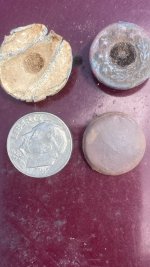longlivethejeep
Jr. Member
I'm just curious if anyone could explain, geologically, some of these rock formations. Just a curiosity. I understand some very basic fundamentals, but everything I know is piecemeal from a few years of googles research. I understand sedimentary rock is a cumulation of years of compression underwater.
1. So... for the first one here, I took this photo at the top of a hill (yes, I realize it would have been under a sea at one time.) How would this swirl have formed into a rock in layers like this? It just stuck out as odd to me.
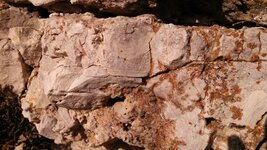
And a close-up:
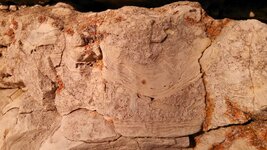
And a reference to how high up we were (no, the toy isn't indigenous to the area, lol)
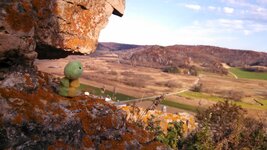
2. Next, what in the HELL causes a perfect hole to be made into limestone (sandstone?) like this one. This was not so high on a different area completely.
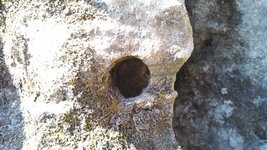
3. This is some fossilized something. Probably aquatic material. Aquatic fossils are the only ones found in my area, both plant and animal, with the exception of a few Mastadons (not to be confused with a much older relative, the mammoth) skeletons, but not sure if those are considered fossils or just bones. My question here is, what made this fossilize, as opposed to just dissentigrating into the sea floor (what was a sea floor at one time) like everything else? Was it a sudden freeze from the ice age, which I understand to be a gradual process? My area is called the driftless area, where the hilly terrain forced glacial progress around us, but apparently didn't have glacial forms. This is believed to be the case due to the lack of loess or drift material that glaciers carry, hence the term driftless. And is the star shaped thing anything or just a coincidence in formation?
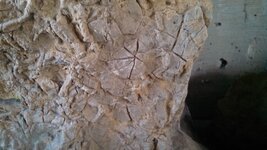
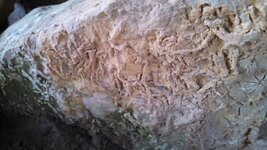
4. What kind of formation is this called, and how did it form? A neighbor owns it and didn't know, just kept it because it looked cool. It is not from Wisconsin, I THINK he said Montana? I can find out if it matters.
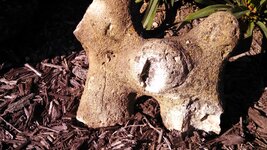
And a view of what's inside from a broken piece.
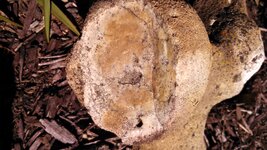
5. And finally, this is a personal find. I dug it out of the side of a creek. It is obviously not THAT old, but how did rock form in it in such a short time (can't be more than a hundred years old, I have identified it as a farm implement wheel)
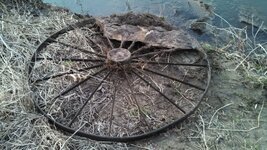
Thanks for anyone willing to teach me something! I numbered the questions for easier reference in answering.
1. So... for the first one here, I took this photo at the top of a hill (yes, I realize it would have been under a sea at one time.) How would this swirl have formed into a rock in layers like this? It just stuck out as odd to me.

And a close-up:

And a reference to how high up we were (no, the toy isn't indigenous to the area, lol)

2. Next, what in the HELL causes a perfect hole to be made into limestone (sandstone?) like this one. This was not so high on a different area completely.

3. This is some fossilized something. Probably aquatic material. Aquatic fossils are the only ones found in my area, both plant and animal, with the exception of a few Mastadons (not to be confused with a much older relative, the mammoth) skeletons, but not sure if those are considered fossils or just bones. My question here is, what made this fossilize, as opposed to just dissentigrating into the sea floor (what was a sea floor at one time) like everything else? Was it a sudden freeze from the ice age, which I understand to be a gradual process? My area is called the driftless area, where the hilly terrain forced glacial progress around us, but apparently didn't have glacial forms. This is believed to be the case due to the lack of loess or drift material that glaciers carry, hence the term driftless. And is the star shaped thing anything or just a coincidence in formation?


4. What kind of formation is this called, and how did it form? A neighbor owns it and didn't know, just kept it because it looked cool. It is not from Wisconsin, I THINK he said Montana? I can find out if it matters.

And a view of what's inside from a broken piece.

5. And finally, this is a personal find. I dug it out of the side of a creek. It is obviously not THAT old, but how did rock form in it in such a short time (can't be more than a hundred years old, I have identified it as a farm implement wheel)

Thanks for anyone willing to teach me something! I numbered the questions for easier reference in answering.
Amazon Forum Fav 👍
Attachments
Last edited:


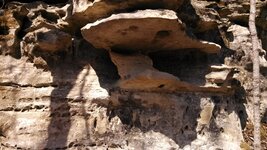
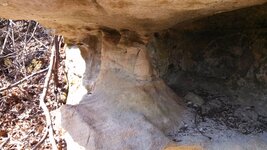
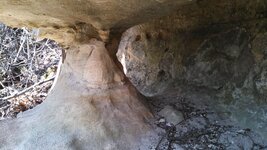
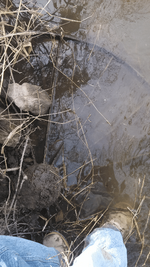
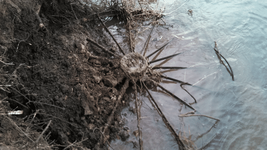
 Most of the material is derived from ancient fossils from old sea beds or other long extinct waterways. Some hold larger fossils, usually shells, but most are microscopic fossils. Water over time often dissolves and redeposits the minerals and "flows" over items left in its path like the wagon wheel. In some caves the bones of extinct animals have been encased and "fossilized" in limestone deposits~ this has been seen to occur in ancient sinkholes. The wavy pictures are good examples of sedimentary deposit. The bone may be an old fossil.
Most of the material is derived from ancient fossils from old sea beds or other long extinct waterways. Some hold larger fossils, usually shells, but most are microscopic fossils. Water over time often dissolves and redeposits the minerals and "flows" over items left in its path like the wagon wheel. In some caves the bones of extinct animals have been encased and "fossilized" in limestone deposits~ this has been seen to occur in ancient sinkholes. The wavy pictures are good examples of sedimentary deposit. The bone may be an old fossil. Animals, like birds, lizards and burrowing mammals often cut into exposed limestones to make their shelters.... or just occupied the holes made by nature though we humans cut into it as well
Animals, like birds, lizards and burrowing mammals often cut into exposed limestones to make their shelters.... or just occupied the holes made by nature though we humans cut into it as well 
